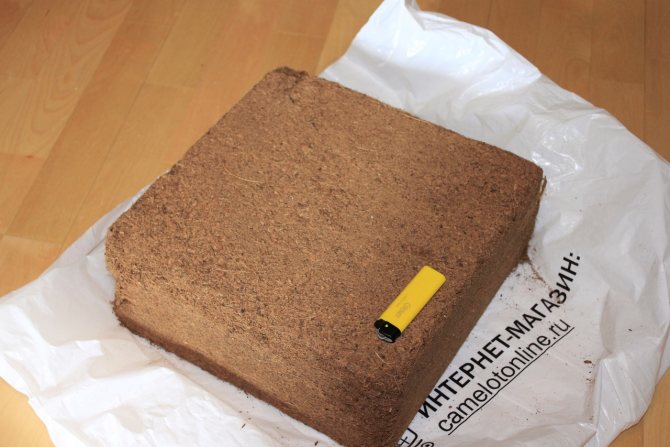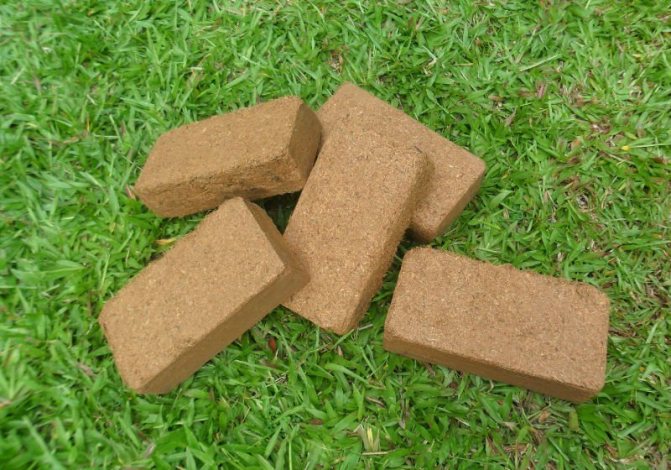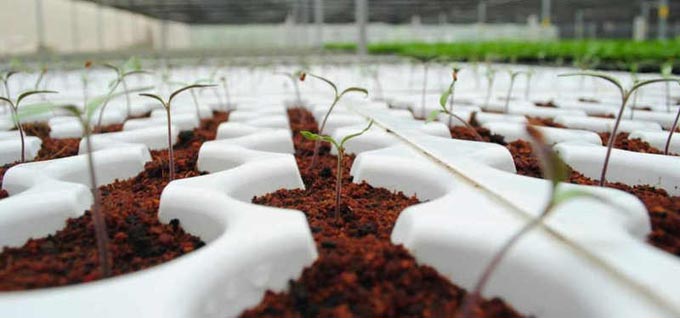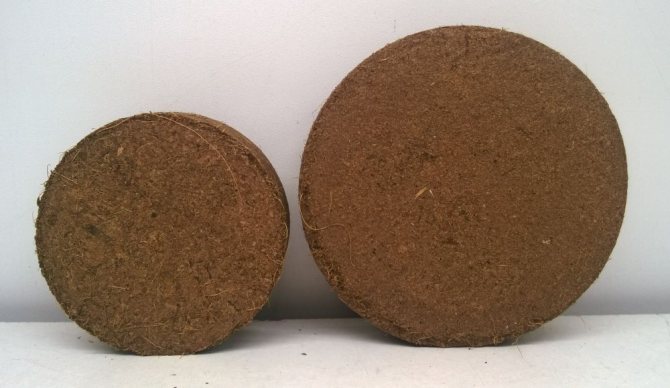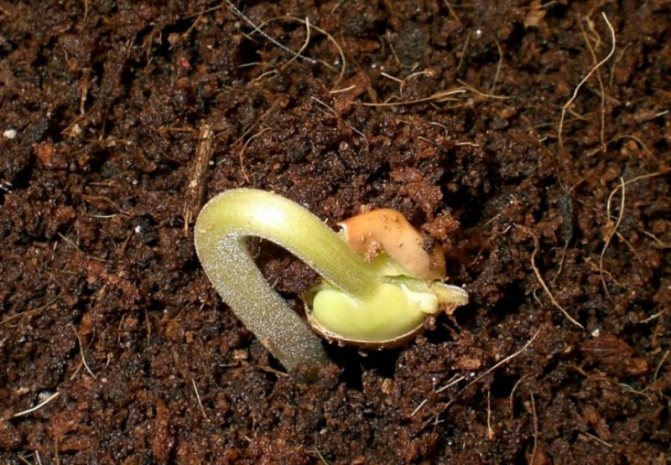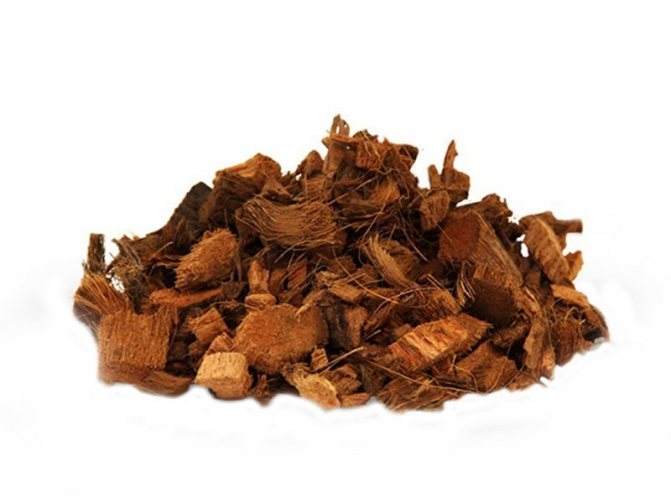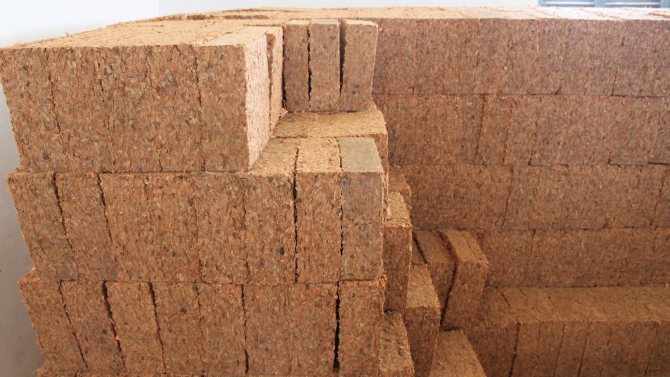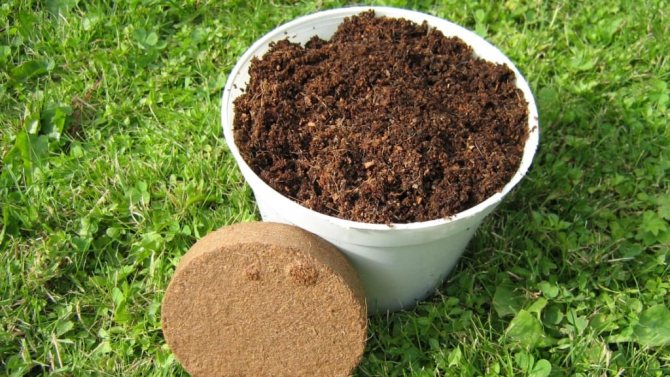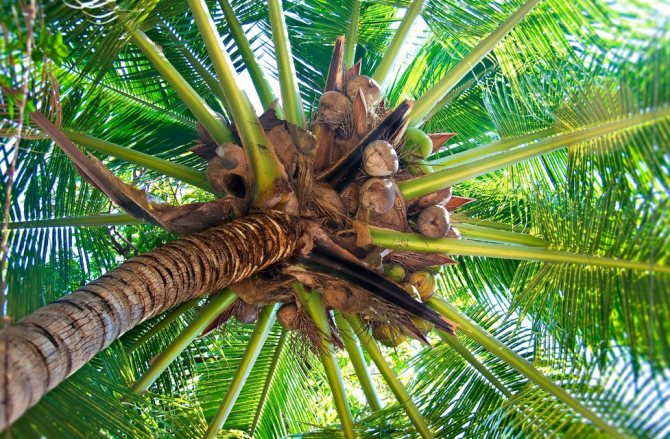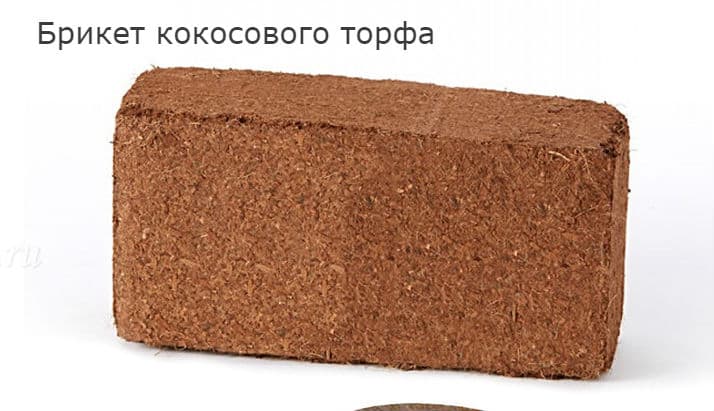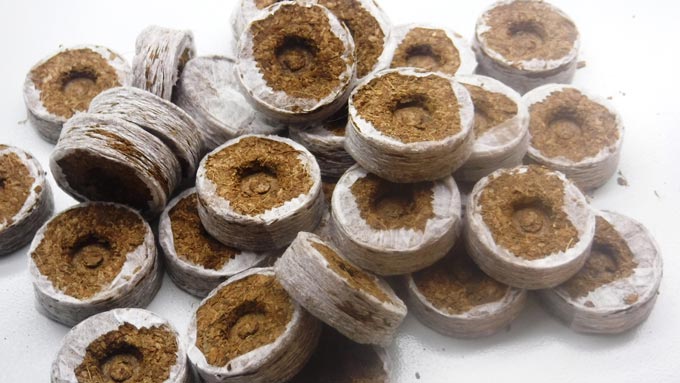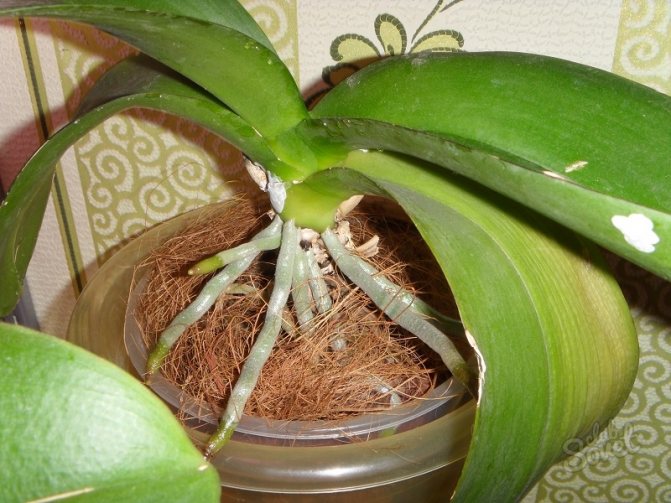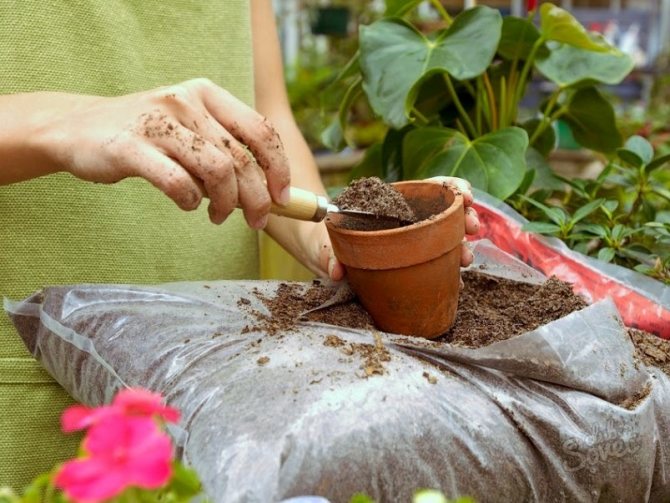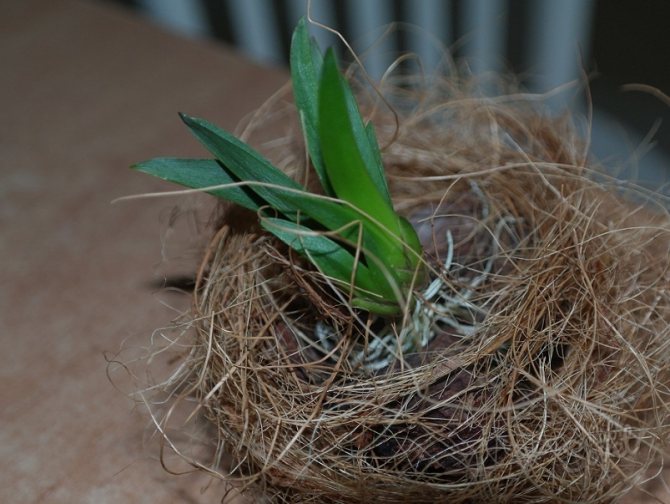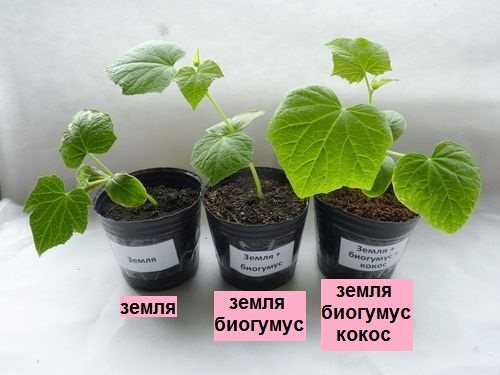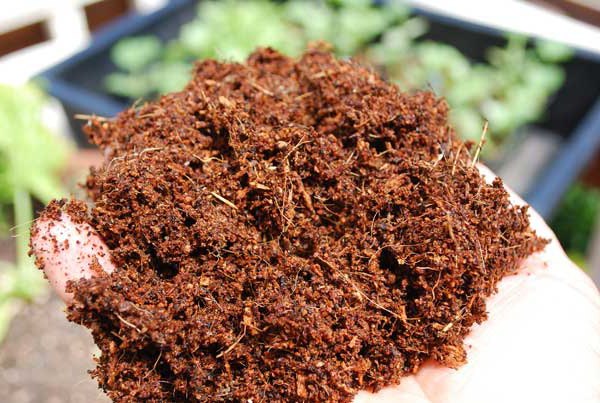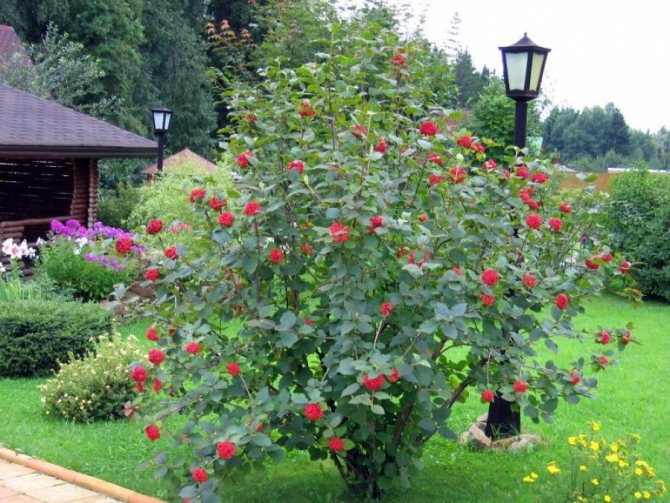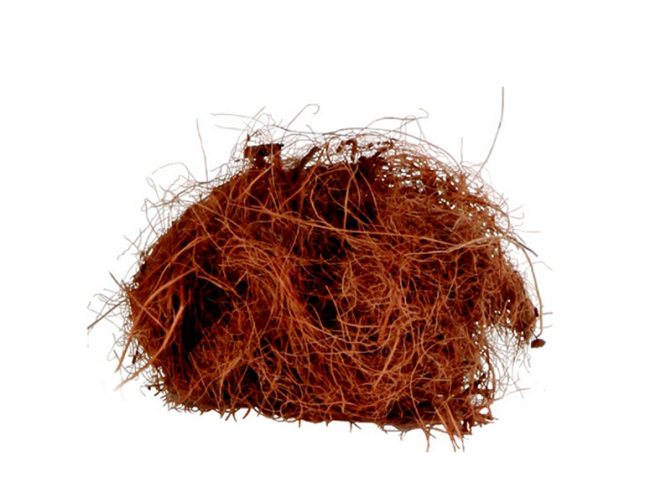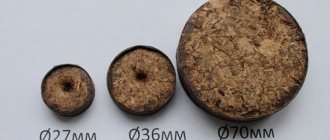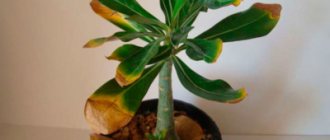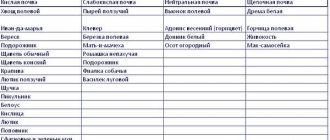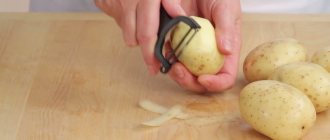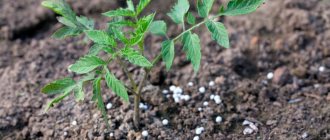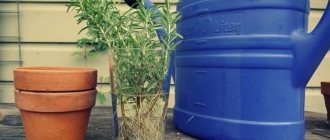If you are preparing soil mixtures for growing indoor plants and seedlings on your own, then you should take a closer look at a relatively new, interesting and, in my opinion, the necessary component - coconut substrate. Everyone has probably seen at least once in their life a coconut and its "shaggy" shell covered with long fibers. Many tasty products are made from coconuts (actually drupe), but shells and fibers used to be just production waste. Then the fibers were adapted for the manufacture of mattresses, and a mixture of crushed shells and the same fibers was adapted for the needs of gardeners. What are these special needs?
Coconut substrate - advantages and disadvantages of using. <игорь>
What it is?
A coconut briquette is a densely compressed substrate under strong pressure, which is a finely chopped coconut skin fiber. It is a completely natural nutrient material that is used to grow various crops, seedlings and indoor flowers, and other garden plantings. One of the modern types of safe substrates sold at any gardening store.
Coke substrate is produced in various forms - bags, mats, briquettes of various sizes. Simply put, a coconut briquette is the most compact and very solid package of the same coconut fiber.
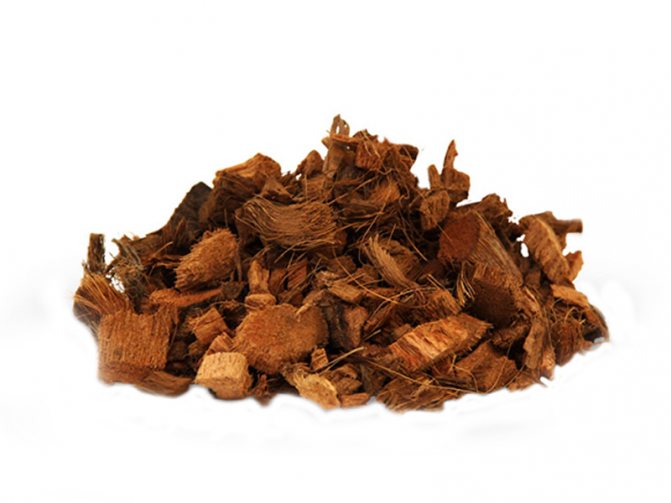
Coconut substrate is shredded and compressed coconut fiber
On a note! Coke substrate (or so-called coco soil) can also be used as a mulching material.
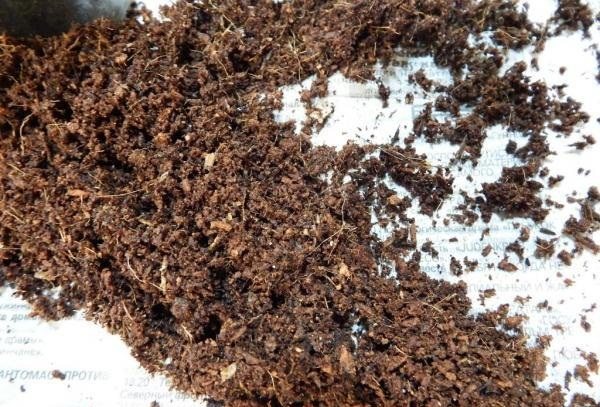

Coco-primer
Testimonials
Those who have already tried coconut substrate on their plants leave only positive reviews:
Rimma:
I successfully use coconut briquettes. I am preparing a soil mixture on its basis for ficuses and decorative deciduous plants. I take 1 part of the usual soil for indoor flowers, 1 part of shavings, add perlite. The mixture turns out to be airy, my plants like it, everything looks great. I water rarely, but abundantly. Moisture, thanks to perlite, is distributed evenly throughout the soil and lasts a long time.
Valentine:
Growing flower seedlings became much easier after I caught my eye with coconut pills. I buy them in many different sizes. I use tablets not only for growing flowers, I also prefer to sow vegetable seeds in them. Previously, I had to spend time preparing the soil: warm it up, spill it with a solution of potassium permanganate. Now I lay out the tablets in containers, fill them with water and that's it, after 30 minutes you can lay out the seeds.
Tanya:
I read a lot of complaints about coconut briquettes on the forums. I disagree with them. A bad result happens when you buy a product from a bad manufacturer. I am lucky, I buy high-quality coco-soil, I grow seedlings of lobelia, petunia. I grow vegetable seedlings, mixing with ordinary soil 1: 1.
How to use coconut substrate for seedlings and indoor plants in detail in the video:
Structure
The coke briquette consists entirely of environmentally friendly natural material. This is the crushed coconut skin and the villi that cover it.Raw materials undergo a fermentation process for 14-18 months, and then they are carefully dried and pressed under high pressure.
In coco-soil, there are no all kinds of artificial growth stimulants, various chemical impurities. But on the other hand, it contains a lot of natural nutrients that have accumulated in the coconut shell during growth. The pH level is 5.6-6.8 and is optimal for growing any plant. It also lacks the larvae of parasites that live in the ground, and pathogens that live in the soil, because they simply cannot get to the coconut developing high on the palm tree during growth.
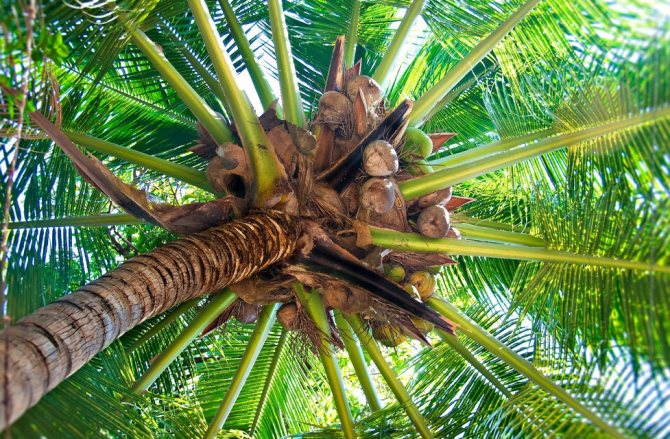

Coconut shells are free of parasites and pathogens
On a note! There are also coconut tablets, which include not only coconut fibers and shavings, but also coconut peat. These are small containers in the shape of a cylinder.
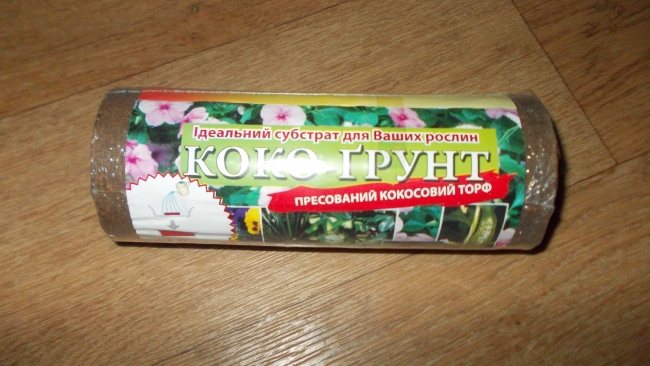

Coco-soil (pressed coco peat)
Coconut briquette prices
coconut briquette
Types and forms of release
Coconut substrate is produced in 3 types:
- Fiber - long filamentary fibers up to 30 cm long. They are distinguished by their strength and ability to retain moisture and prevent its evaporation;
- Peat - the most moisture-consuming product. Obtained by fine grinding of walnut shells;
- Crisps - less moisture-absorbing, but good air permeability. These are large particles of crushed shells.
The preparation of the coconut substrate itself takes almost 1.5 years. Its technology is rather complicated, since the shell is first crushed, then it undergoes fermentation, only after that it is dried and pressed. The substrate is released in the form
- Brick-like briquettes, when soaked, increase 2-3 times;
- Tablets packed in fine mesh so that they do not crumble;
- Mats - coco peat, absorbs little water, intended for growing plants directly in the package.
Properties and advantages
Coconut fiber substrate has a lot of unique physiological properties, which are practically not lost even after the time of use.
- The composition of the substrate is completely natural - it is organic matter in its pure form without admixture of chemically active artificial substances.
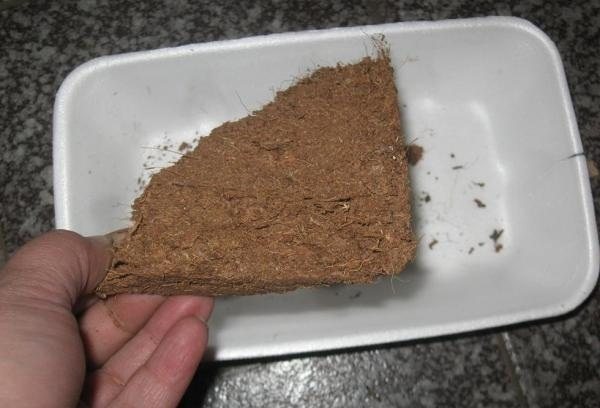

Coco-primer Ceres
- Coke substrate perfectly absorbs large volumes of water and is able to retain it for a long time. Due to this, the frequency of watering can be reduced. The volume of the absorbed liquid exceeds the volume of the soil itself by 8-10 times. When the coconut substrate is well hydrated, it changes its color to dark brown. When dry, the fiber has a light nut color.
- Coco soil does not absorb excess water, therefore overflow of plants is excluded.
- Various pathogenic representatives of the fungal kingdom and other parasites do not live in it. But at the same time, the soil is favorable for the development of useful and necessary microorganisms for plants.
- Useful elements and nutrients in the coconut substrate are retained for a longer period than in ordinary soil, since they are not washed out with water during frequent watering.
- The airiness and porosity of the soil provide favorable conditions for the growth of plant roots. Thanks to this property, they root well, and the seeds germinate better and faster. The seedlings are strong and healthy.
- Coke substrate can be used several times, as it retains its properties for a long period of time - about 5 years.
- Coco-soil provides good aeration to plant roots - even at 100% moisture saturation, it contains at least 15% of air, or even all 30% (depending on the size of the fractions).
- The pH is optimal for growing plants (5.6-6.8).It is this level that parasites and pests do not like, but plant organisms "respect".
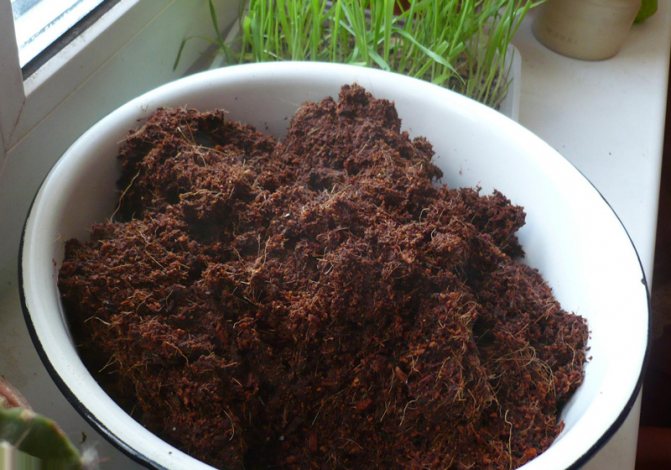

Wet coconut substrate has a dark brown color


Coconut soil (pressed coconut fibers) is the ideal landless growing medium for hydroponic growing
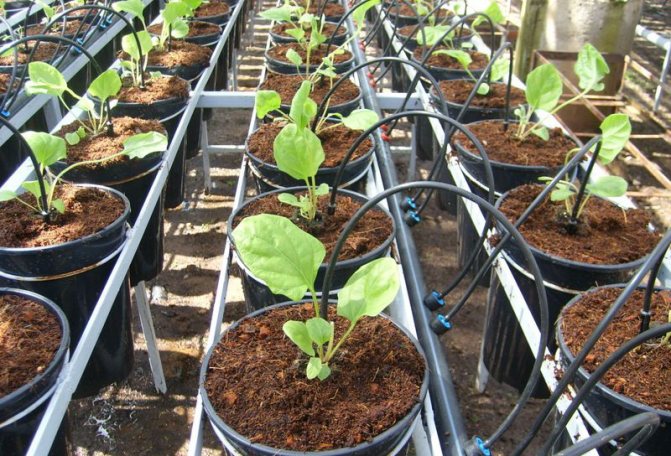

Gerbera seedlings in coconut substrate
Thanks to the use of coconut substrate for growing seedlings, due to its unique properties, it is possible to minimize the risks for the future harvest. Also, this material can be mixed with other types of soil, thereby improving their structure, increasing their fertility and turning even loam into a nutritious soil mixture. The effectiveness of planting seeds and growing seedlings increases significantly.
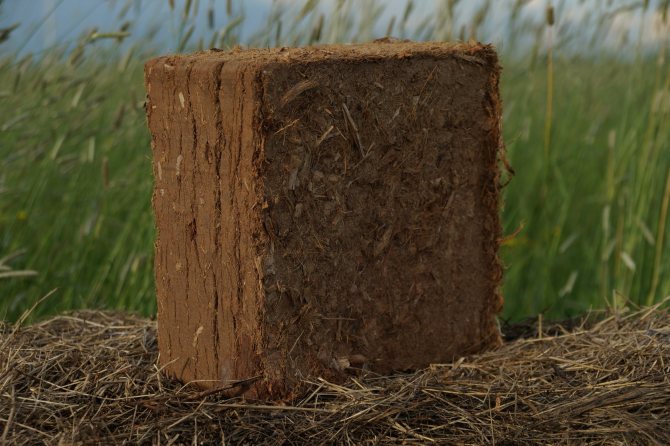

The use of coconut substrate minimizes possible risks to plants
Advantages and disadvantages
The absence of chemical impurities is the main advantage of coconut peat, its composition is a pure organic product. Florists who use it get a number of benefits:
- Chips like a sponge absorb moisture and retain it for a long time.
- There is no moisture on the surface of the coconut fiber, so there is no favorable environment for the growth of fungi.
- Coco soil has the most acceptable pH level for most indoor plants (5.7-6.5).
- In the tissues of coconut fiber there are micro and macro elements necessary for plants (potassium, phosphorus), it is able to accumulate them.
- The long decomposition period of the organic fiber guarantees its long-term use for 5 years.
- The fiber provides the roots with the necessary aeration and drainage.
- Cocoa soil is odorless, which increases the comfort of its use.
- The fiber is pleasant to the touch and can be easily mixed with soil to obtain a uniform consistency.
- The content of cellulose and ligin in the shavings promotes the multiplication of beneficial bacteria (trichoderm).
- There are no harmful microorganisms, adults, larvae and eggs of pests.
Do not gloss over the shortcomings. On the market, you can find a low-quality product from an unscrupulous manufacturer that uses sea water for shell processing.
Tip: If you purchased the product from a dubious seller, rinse the substrate in cold, running water. This will protect your flower from excess salt.
Application
You can use coconut for a variety of purposes, depending on what you want. This primer is great for any plants, including decorative ones. This is confirmed by numerous positive reviews from experienced and novice gardeners.
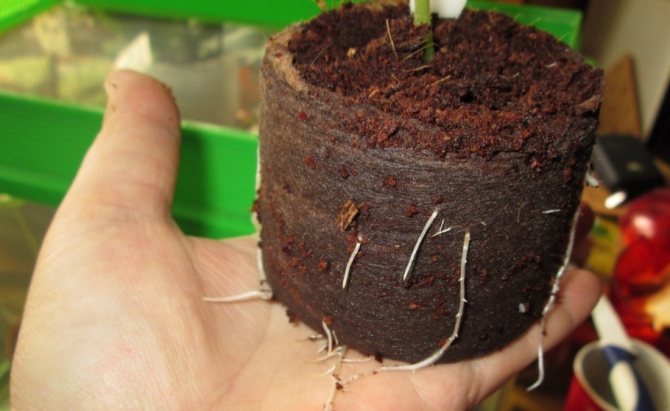

Swollen Coconut Pill with Sapling
Table. Ways to use coconut briquette.
| Method of use | Description |
For growing seedlings | In this case, the coke briquette is soaked, and the resulting loose mass is mixed with ordinary soil in a 1: 1 ratio. In some cases, it can be used in its pure form. Of course, it is easy to find topics on the Internet that compare coconut substrate to lifeless perlite. But the soil obtained from the briquette is still a "living" organic material. A variety of plants, including orchids and ficuses, thrive in a pure coconut substrate. |
To improve the quality of the soil | Dry coconut substrate can be added to regular ready-made or homemade soil. The material improves the quality of the soil, making it more airy. |
For indoor plants | The briquette is used in the same way as for growing seedlings. It is safe and not a breeding ground for small midges that growers often encounter. Coconut substrate is ideal for rooting cuttings of various colors - fuchsia, violets, begonias, geraniums and others. It is enough to place the shoots in the ground and lightly tamp it around, and then cover the container with the handle with a bag. |
For planting vegetables, flowers | Briquette coke substrate can also be used for planting plants in open ground. For this, the substrate is introduced into the ground in the garden bed and dug up.In order not to overdo it with the quantity, first place it on the surface of the ridge with a layer of about 7 cm. |
For shrub plants | If you decide to use soil for planting shrubs and trees (which is also very good for them), then place soil from soil and coconut substrate in a 1: 1 ratio in the prepared hole and plant the plant in it. |
For mulching | The substrate obtained from a coconut briquette is also excellent for mulching beds. True, this method is not cheap, but it saves time and effort, and the quality of such mulch is excellent. |
On a note! Interestingly, coconut fiber can even be used as bedding for pets in terrariums, cages, and aviaries. This material is hygienic and practical, it is also easy to use.
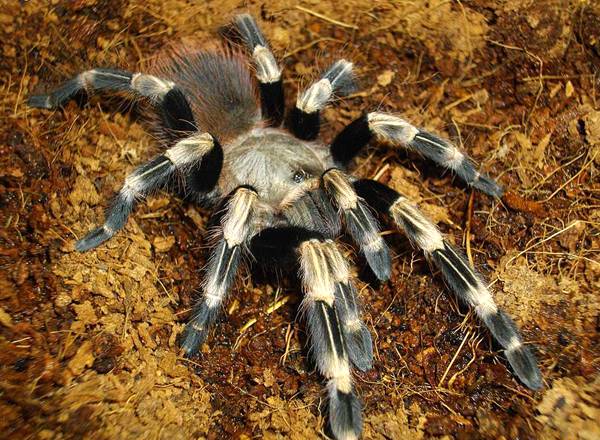

Tarantula spider on coconut bedding
How to prepare the soil
To prepare the substrate, the soil requirements are first calculated. Keep in mind that 1 kg of dry coconut substrate makes 15 liters of soil. Usually, briquettes are sold on sale, from which 4 or 7 kg of coconut soil are obtained (this is written on the label). How to use a briquette, there is all the information on the package. But for those who have not yet bought briquettes, I will tell you how to prepare the soil.
First of all you will need
- 10 liter bucket or basin,
- about 5 liters of warm water,
- and the briquette itself with a dry substrate.
To prepare, for example, 7 liters of soil, put the briquette in a bucket or basin, pour 3 liters of warm water there, leave for 20-30 minutes. After this time, the substrate swells, increases in volume and gradually disintegrates. The result is a loose, airy soil, ready for use.
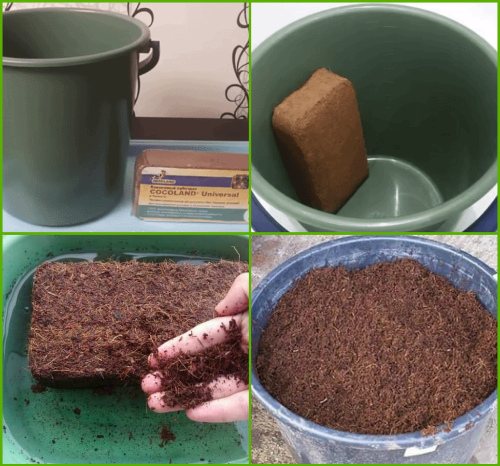

Useful addition
By itself, the coconut substrate contains no nutrients. That amount of nutrients contained in it is extremely insufficient for growing seedlings until they are planted in the ground. In the best case, there will be enough nutrition only until the cotyledons appear on the seedlings.
To avoid nutritional deficiencies, add 1-2 caps of any fertilizer to the water while preparing the soil. Only then can the seedlings grow in the substrate before they are planted in open ground.
To obtain food for plants, they do it in a different way. Before sowing seeds, the nutrient soil is diluted with coconut in a ratio of 1: 3. Of course, do not forget about the rules for growing seedlings for a particular plant.
Step by step instructions for use
You can buy coconut briquettes for growing seedlings at any gardening store. Moreover, they are of different production and quality. The main thing is to choose the one that suits you specifically. How to use this unusual briquette, which can easily turn into a substrate?
Step 1. Calculate your needs. Remember that when a 1 kg briquette swells, a lot of substrate is obtained - about 7-8 liters. Think about how much coco soil you need right now. Let's say you need all these 7-8 liters, then prepare a container of about 10 liters for soaking the briquette.
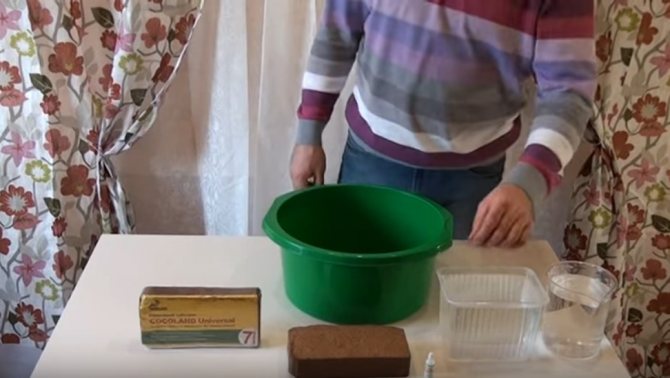

Preparing everything you need
Step 2. Unpack the briquette and place it in a container, fill it with a little warm water. After a while, if necessary, it can be divided into several pieces and placed in different containers.
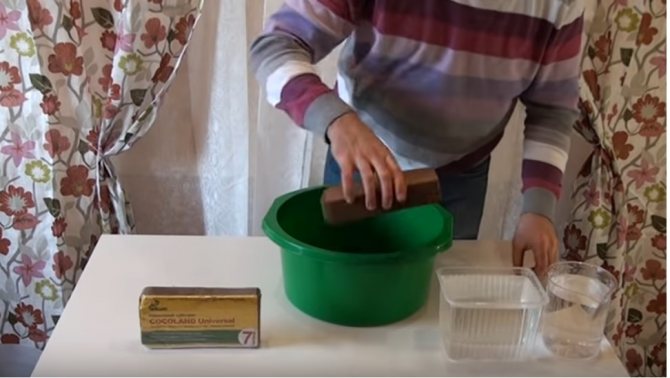

Coconut briquette is placed in a container
Step 3. Fill the container with pieces of briquettes completely with water. If you do not need to divide it, you can immediately pour a full 10 liter container of water. The "brick" will soften completely in 15-30 minutes.


Water is poured into a container with a coconut briquette
On a note! Rinse coke soil thoroughly with water before use. The fact is that it may contain an excess of sea salt (it is used in the technological process during production), which will negatively affect the condition of the plants. But these salts are easily washed out with water.For this, the swollen substrate can be placed in a colander and rinsed.
Step 4. After washing the soil, put it to dry. This process lasts about 2-3 weeks. Loosen the substrate periodically while drying. However, even at the end of the drying procedure, the soil will be slightly damp - this is normal and due to its moisture holding capacity.
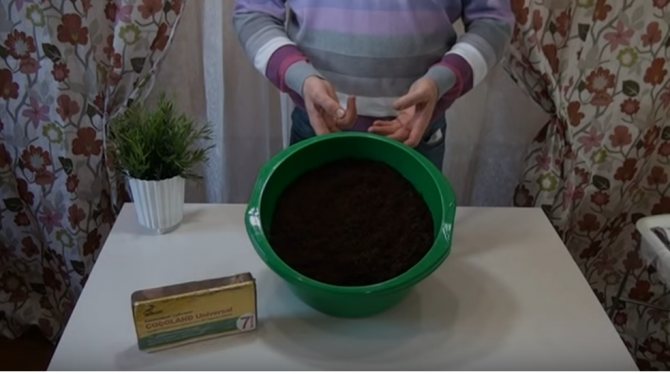

Ready coconut substrate
The result is a pleasant, loose, airy structure reminiscent of high peat in color. And it can already be used in accordance with your needs and wishes. Remember that seedlings can be planted both in a clean substrate and in a mixture of it with garden or purchased land.
After the seedlings have been grown and planted in the ground, you can free up the coconut substrate, but do not rush to throw it away, because it can be reused. To do this, first place it in a container and fill it with an aqueous solution of an EM preparation that prevents the development of various harmful fungi (they could get into the substrate during use). Moistening periodically, give the substrate time to infuse for about a month, after this disinfecting procedure, you can again use coconut fiber obtained from the briquette.
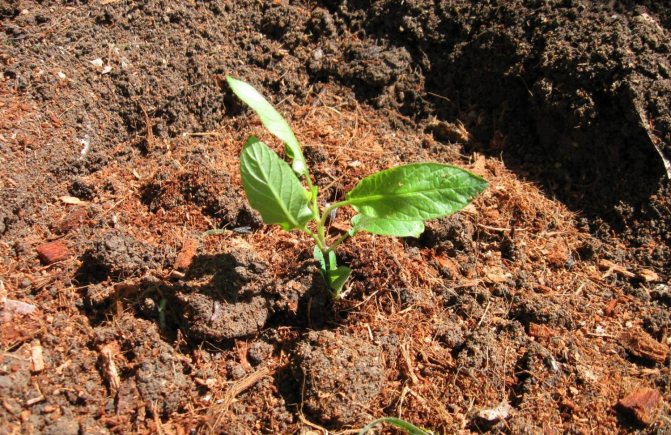

The seedling is planted in a mixture of humus, coconut substrate and garden soil
It is also believed that excellent soil can be prepared on the basis of the substrate obtained from coconut briquettes. To obtain 100 liters of soil mixture, you will need a briquette of coconut fiber weighing 5 kg, 1 liter of liquid vermicompost and 25 liters of dry, as well as 23 liters of ordinary water. Liquid vermicompost is stirred in clean water, then a coconut briquette is placed there, which it is desirable to press down with something to the bottom. The swelling soil is transferred to a clean container and then mixed with dry vermicompost.
The resulting soil mixture can be used for seedlings or any horticultural needs associated with growing, replanting plants. It will be very crumbly and airy, as well as enriched with nutrients and substances, the supply of which will last for several years in a row (about 5-6). If excess soil is packed in bags and compressed, then it can be stored for a very long time.
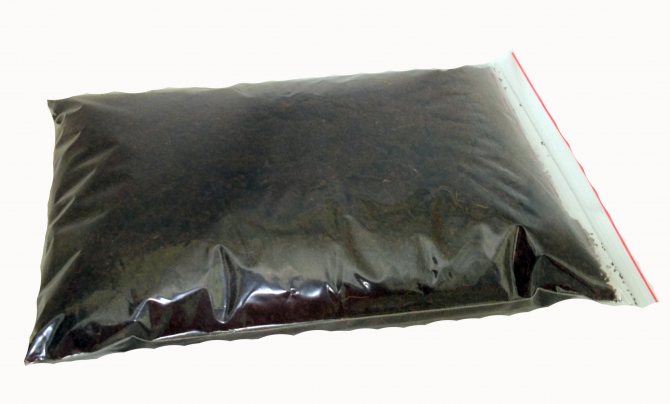

Packaged soil mixture
What is it for
The product of coconut shell processing can be used in plant growing in any form. They replace soil for seedlings, supplement soil mixtures for flowers (orchids, violets and others), mulch young sprouts or trees, creating insulation for the root system for the winter. The new-fangled product proved to be excellent in the cultivation of most moisture-loving crops. Experts recommend preparing a universal mixture from it as follows:
- Dilute 1 liter of vermicompost (in the form of liquid) in 25 liters of tap water.
- Soak 1 briquette of nut shell substrate in vermicompost.
- Thoroughly mix 25 liters of clean and dry vermicompost with the swollen substrate.
Read also: How to plant and grow a columnar juniper
This mixture contains all the necessary trace elements and nutrients.
How to choose a coconut substrate?
Coke substrate can be sold both in briquettes and in seedling cubes, mats, bags. When choosing the one that is right for you, focus on the acquisition goals, brand awareness, the total amount of substrate and other parameters.


Coconut pills
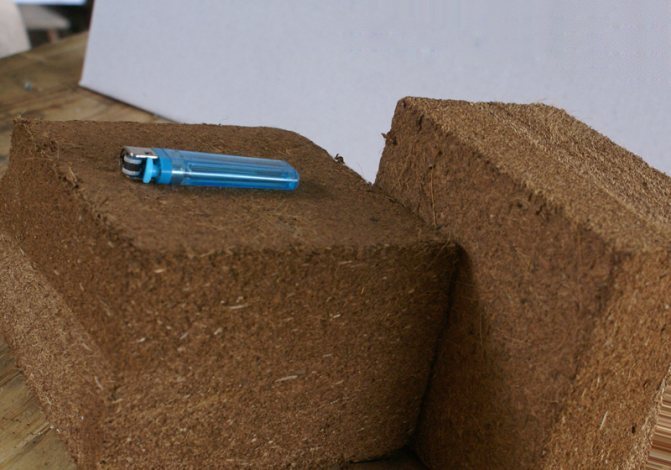

Coconut briquette
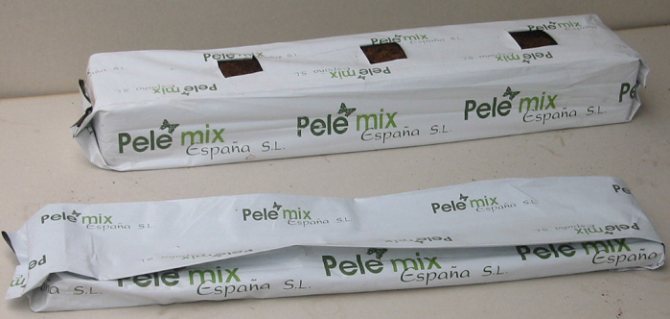

Coconut mats
For example, there are not only briquettes, which, when swollen, will give a large amount of substrate, but also small briquettes, packed and acting like peat tablets. They are plates or cubes that swell when moisture is added and fill the mesh bag in which they are located. At the same time, they do not crumble, and seedlings and plants can be planted directly in them in special holes in the package.


Seedlings in coconut tablets
On a note! There are many manufacturers of coconut briquettes, but the brands Cocoland, Growblock, Profimix are very popular.


Coconut briquette Cocoland


Coconut substrate Cocoland


Coconut substrate UGro Small


Jiffy Growblock Coconut Briquettes
Fibers in briquettes can be of various sizes - large, medium and small. For seedlings of vegetable crops, it is better to use a substrate with a small size fraction, and for certain types of flowers - with a large and medium size.
Also briquettes are different in weight. It is better to buy a small package for the first time. If you like the properties of the soil, then later you can purchase it in large quantities.
Sowing and growing flower seedlings
The ideal planting soil should be light and loose, have a porous structure and adequate aeration, and match the type of crop intended for the soil. Read more in this article.
By the way, briquettes are very well transported - they take up little space, and therefore they can even be ordered by mail, if suddenly they are not on sale in your city. If you have never used a coconut substrate, then maybe you should finally get it and use it for the benefit of your plantings? It will definitely not harm the plants, but maybe you will like it in use.
Coconut pill prices
coconut pills
Features of coconut soil
The material is produced in the form of briquettes, blocks, mats, or tablets. The soil differs not only in shape and size, but also in structure. When it is processed, the fibers are washed, beaten until soft, then straightened and laid. In some cases, the fibers are additionally refined. As a result, three different fractions of coconut soil come out: chips, fiber and peat. The latter is distinguished by its ability to retain the greatest amount of liquid, however, it does not provide sufficient oxygen to the roots, therefore it is not used as the main soil and is usually added as an additional component to other garden soil.
Coconut soil is best suited for growing a variety of ornamental plants. In it, their root system will develop most actively without the threat of being damaged by diseases and microbes. As a result, the green mass of the flower is formed much faster and denser.
What else is the material suitable for:
- Houseplants;
- Garden flowers;
- Forcing flowers (such as rose, gerbera, chrysanthemum and others);
- Greenhouse vegetables;
- Strawberry.
Plant substrates: a new word in agriculture
I have long suspected that the main reason for my garden failures is the soil. But having tried all the soils on sale, I did not get the desired result. Until I came across a note about the Dutch bio-boom: they began to use plant substrates for growing environmentally friendly products.
These are chemically neutral mixtures of natural origin (crushed tree bark, seed husks, plant fibers, etc.). The best substrate, according to European ecologists, is coconut. It is sold in the form of tablets, briquettes, mats. The common name for these products is coconut earth or coco soil.
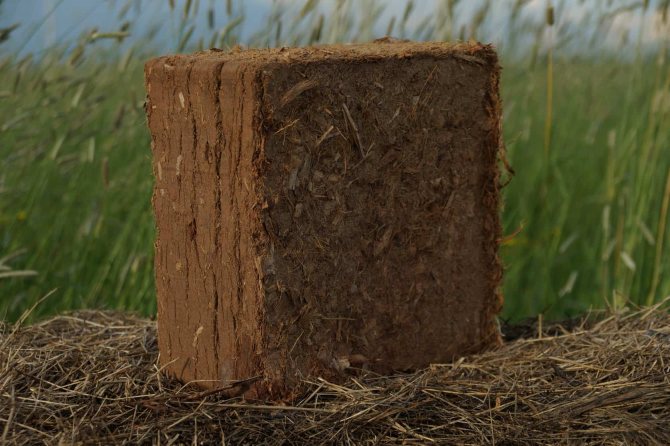

Soil properties
Any soil is characterized by the following parameters:
- acidity;
- mechanical structure;
- breathability;
- the ability to absorb and retain moisture;
- the degree of damage by pathogenic microflora;
- the ability to compact ("caking");
- the likelihood of crust formation on the surface (crusting).
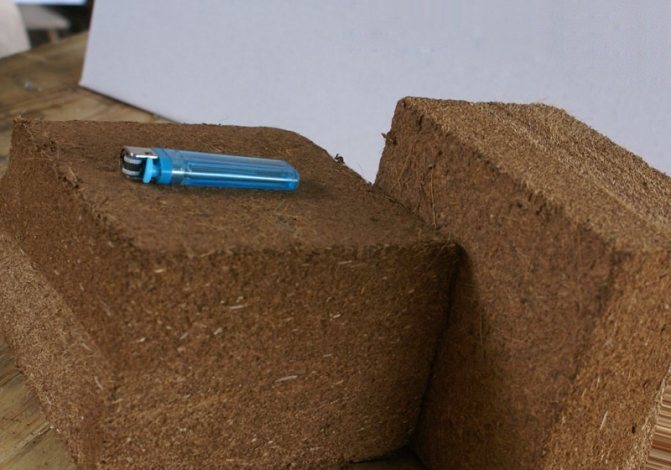

Characteristics and purpose of coconut peat
The coconut residue looks like peat, it is a heterogeneous mass of fibers and shavings.The composition can be enriched with useful substances, it is often used in briquettes for greenhouse crops, only in atypical situations - for open planting.
The bark of a palm nut can be crushed in different ways:
- in the form of flakes, comparable in size to pieces of tree bark;
- as peat, it is the finest fraction, which makes it possible to achieve the structure and properties of the soil, the method helps to achieve maximum moisture capacity;
- coir - here the waste is cut in such a way that strong fibers are preserved, reaching a length of 30 cm.


What does coconut peat look like?
After the bark has been crushed, it is combined with wood chips. To increase the crop's chances of thriving in coco-peat, it is transplanted into the ground in parallel with the introduction of top dressing. In this connection, the product in question is often laid in multicomponent fertilizers.
Coconut substrate and coco peat have an important difference - the latter is characterized by enhanced moisture retention properties. It should be borne in mind that peat is dry, so it is not immediately saturated with moisture. The substrate has a neutral acid-base index, it is easy to transport. The primer is offered in a pressed form, characterized by compact packaging and sterility in this form.
How to prepare the ground for seedlings - composition and proportions
At the initial stage of plant development, it may well do without land, since the seed germinates, gives seven-lobed leaves, and all this is due to energy and nutrition from the seed itself. But in the future, for the full development of seedlings, one cannot do without high-quality soil. Growing seedlings require more nutrients. And when there are a lot of seedlings, then a lot of soil mixture will be required. Only one plant, such as a tomato, will require at least 1 liter of soil. And if you buy, it will turn out to be quite expensive for your wallet.
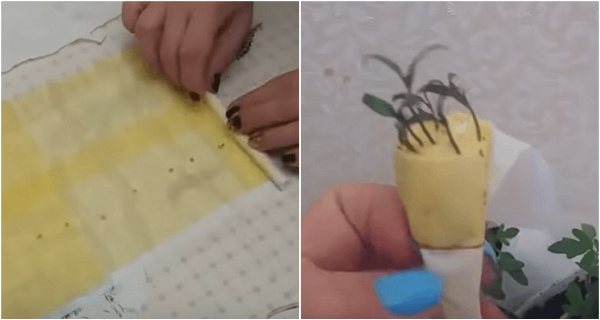

Of course, the soil for future seedlings can, and even need, be prepared in the fall, when the entire crop has been removed from the garden. But who did not do it in time, you can prepare it just before sowing the seeds.
With self-preparation of the soil mixture, there are no exact proportions and everything depends on our conditions and capabilities. The approximate composition and proportions may be as follows:
- compost - 25-50%,
- land - 20-25%,
- sand - 10-15%,
- peat - 30-35%.
Depending on the initial composition, there may be additions in the form of perlite or vermiculite, but we'll talk about this a little later.
As you can see, the main component of the seedling soil is compost. The rest of the components can change or be present all at once. It is better to sift the compost, and you can use a plastic vegetable bin for this. Sifting the compost, all large fractions of the earth (pebbles, sticks, etc.) remain in the box. Earthworms may remain in the sown land, they are also useless here, they need to be removed. After sifting, the soil becomes homogeneous, breathable and loose, which is what you need, especially for small seeds.
The compost is best mixed with turf soil. To do this, remove the top layer of sod, and what is under it must be sieved and added to the compost. Another very good sod land is the one dug by moles. It is loose, does not contain roots and pebbles, and it is quite possible to add it to the soil mixture.
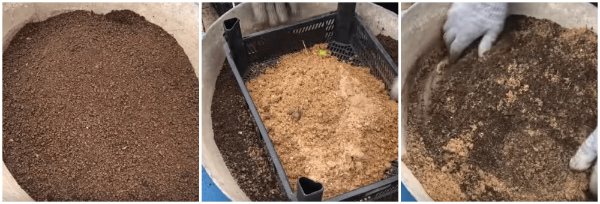

Is it possible to take land from the beds? There are opponents and supporters of this method. Opponents argue that various pathogenic microflora can be brought in from the soil, while supporters argue that plants in the seedling stage do not need to be grown under sterile conditions and they should be close to the microflora in which they will then grow.
If you are afraid to bring a spider mite, then take the ground from under the cabbage. You can also add tobacco dust to the ground and mix.
Sand makes loam or clay soil more breathable and friable, it also needs to be sieved.If there is no sand, it can be replaced with perlite or vermiculite.
If possible, peat is added to the soil to increase the moisture capacity, it is better to take a horse bog. But keep in mind that high peat has a high acidity. Then wood ash is added for deoxidation. Both peat and ash also need to be sieved.
It remains only to thoroughly mix the entire soil mixture, and it is ready for planting seedlings in it.
And one more way to make good nutrient soil using bokashi. Bokashi is one of the world's most popular microbiological fertilizers to restore the natural fertility of the soil.
Disinfection of soil for seedlings
Often having prepared the soil according to all the rules, after a while we notice that the seedlings begin to hurt. The main reason for this is the presence of pathogenic microflora in the soil, most often fungi. Therefore, it will not be superfluous to decontaminate the soil before sowing seeds.
At home, this can be done in several ways.
- Freezing at low temperatures, leaving seedlings in cold rooms, where the temperature is close to outdoor;
- By calcining at high temperatures. To ignite the soil, it is scattered on a metal baking sheet with a layer of no more than 5 cm, the earth is spilled with boiling water, and then placed in the oven at a temperature of 70-90 ° C for half an hour. The temperature should not be higher than the indicated one, otherwise a higher temperature will lead to nitrogen mineralization and deterioration of soil quality.
- By steaming, spilling the earth with boiling water or pouring it into a colander, place it over a saucepan of boiling water for 10 minutes;
- Etch with a pink solution of potassium permanganate. For a more thorough treatment, antifungal drugs are used: Fitosporin, Baikal EM-1, Zamair, Vozrozhdenie;
- Spilled with a solution of potassium permanganate, the soil is placed in a microwave for 3 minutes, turning it on at full power.
All methods of disinfection are good, but they all have one significant drawback: along with the pathogenic microflora, all useful ones also die. Therefore, such treatments are carried out 2-3 weeks before the intended use. It is possible to store the prepared and disinfected soil in the conditions of an apartment until sowing seeds or before picking seedlings.
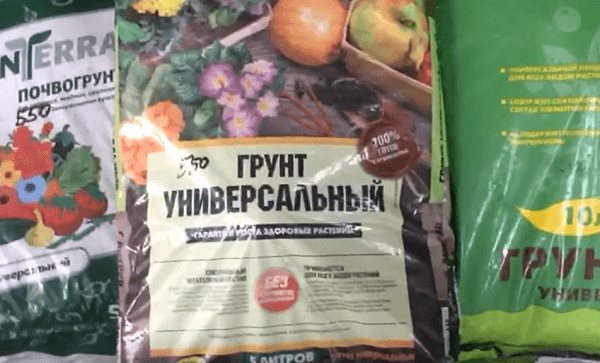

Areas of use
The possibilities of using peat in briquettes are not limited to such large cities as Moscow; it is in demand in the regions as well. It can be used as a soil additive:
- for growing vegetables in open beds;
- for the cultivation of indoor flowers, even their most capricious varieties;
- as mulch, which is distributed between the bushes and in the beds, subsequently it is transformed into organic matter;
- for container plantings in the open air;
- to maintain seedlings in greenhouses and greenhouses;
- for growing decorative varieties in greenhouses, winter gardens, pavilions;
- as a bedding for small exotic pets such as snails, lizards, turtles.
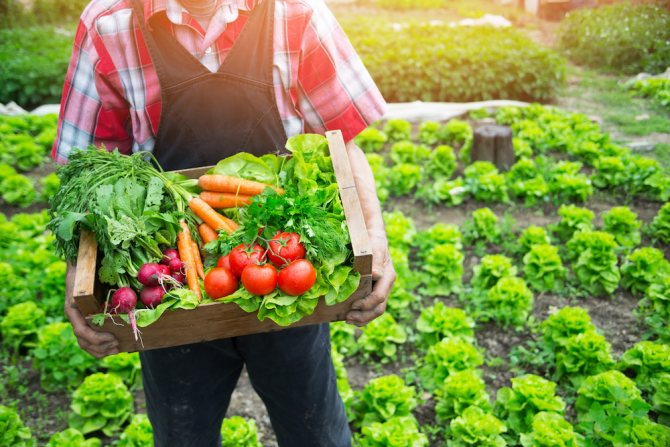

Coconut peat is used for growing vegetables in open beds
You can also use coco peat as a base for growing bulbous flowers such as dahlias, lilies, peonies in open beds.
Preparing the soil for tomato and pepper seedlings
Tomatoes and peppers are some of the favorite crops among gardeners. And the attitude towards them is special, so the soil for them is prepared or bought special, specifically for these crops. Important conditions for growing healthy and strong seedlings should be as follows.
- The fertility of the earth, that is, both organic and mineral components must be present in the soil;
- Balance of nutritional and mineral components;
- Availability of assimilation of nutrients, that is, the soil must be breathable and loose;
- Moisture capacity of the soil, in other words, the soil should absorb moisture well and give it back to the plant;
- Acidity (pH) should be in the range of 6.5-7.0, tomato seedlings especially do not like acidic soils;
- Safety - the soil should not contain various pathogenic microorganisms and parasites, as well as salts of heavy metals that are present in the soil taken along roads or railways.
Seedling soil must contain both organic and inorganic components, the list of which is written in this table.


Should not be added when preparing the soil:
- Clay, it will weigh down the soil and restrict the access of air and nutrients to the roots of plants;
- Fresh manure or poorly rotted compost. Added to the soil, overcooking, the released nitrogen will heat the earth, and the young roots of the shoots will die from the high soil temperature;
- Wood sawdust, they acidify the soil.
How to properly prepare the soil?
- We combine sifted compost, peat, turf soil;
- To loosen the soil, add sand, vermiculite or perlite (optional);
- Part of the soil can be replaced with coconut substrate;
- To deoxidize the soil, add wood ash or dolomite flour (do not add sawdust;
- If necessary, in the absence of sufficient compost, a little urea (nitrogen fertilizer) or potassium superphosphate (potassium fertilizer) can be added.
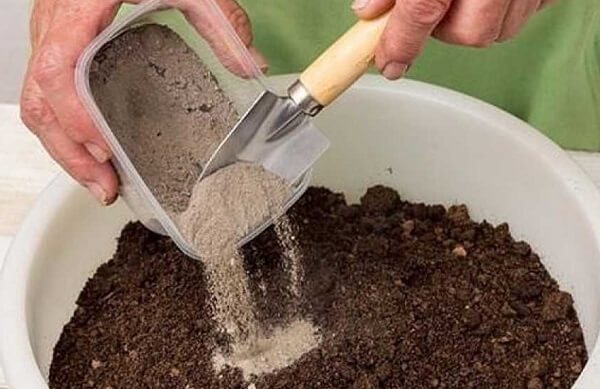

All components are well mixed and then the soil must be disinfected in any of the ways described in this article. After that, the soil is left for a while so that it cools down and populates with useful microflora, and only after that you can sow seeds into the ground.


